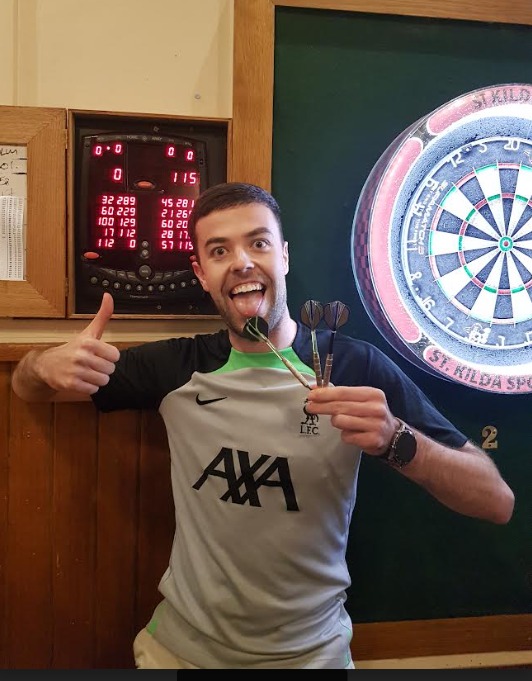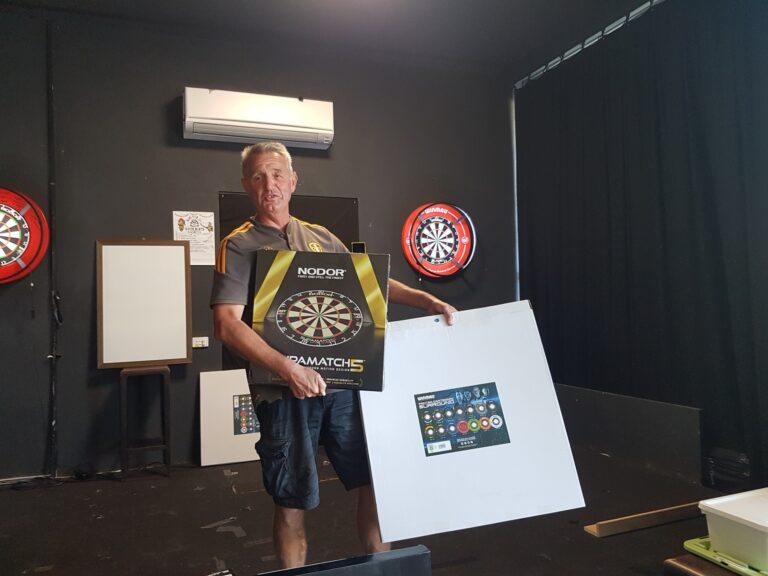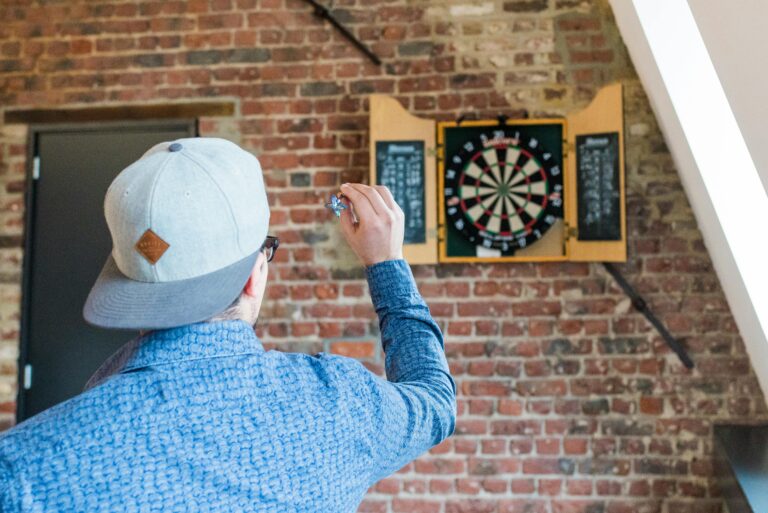Mastering Beginner Dart Throwing Techniques
When you’re starting out with darts, mastering the basics can feel overwhelming, but it’s essential for building a strong foundation. You’ll need to choose the right equipment, find a consistent stance, and learn how to grip the dart properly. Each element plays an important role in your success, and honing these skills can greatly improve your accuracy and control. However, the real challenge lies not just in physical techniques but also in developing a mental strategy to stay focused and calm under pressure. Curious about how to seamlessly combine these aspects?
Key Takeaways
- Choose a dartboard with tightly packed sisal fibres and experiment with various dart weights and grips.
- Maintain a square stance with relaxed body posture and minimal movement for accuracy.
- Practice a consistent dart grip that balances comfort and stability to build muscle memory.
- Focus on a smooth throwing motion, generating power from the elbow and consistent release.
- Set clear practice goals, track progress, and establish a regular practice schedule.
Selecting the Right Equipment
Selecting the appropriate equipment is essential for enhancing your dart-throwing skills. Start by choosing a dartboard made from tightly packed sisal fibres. These boards guarantee consistent dart penetration and are known for their durability. Popular brands like Viper and Unicorn provide high-quality options that many players trust.
Next, you’ll need to decide between steel-tip and soft-tip darts. Your choice depends on the type of dartboard you have. Steel tip darts are ideal for bristle boards, whereas soft tip darts are better suited for electronic boards. It’s important to match your darts with your dartboard to ensure top performance and safety.
Finding the right dart can make a significant difference in your game. Experiment with different weights, barrel shapes, and grip types to find what feels best. Some players prefer heavier darts for stability, while others might favour lighter ones for speed.
The barrel shape and grip should fit comfortably in your hand, providing a secure and controlled throw.
Developing a Consistent Stance
Now that you’ve chosen the right equipment, let’s focus on developing a consistent stance to improve your dart-throwing accuracy. A good stance sets the foundation for a successful throw, ensuring balance and alignment.
Start by standing square on the board with your dominant foot slightly forward. This positioning helps you maintain ideal balance and alignment with the target.
Distribute your weight evenly between both feet. This balance prevents swaying and keeps your throw steady. Your body should feel relaxed to avoid any tension, which can negatively affect your throwing motion and accuracy. The more relaxed you are, the smoother your throw will be.
Minimise excessive movement to keep your stance consistent and repeatable for every throw. A steady stance is essential for accuracy and control. By focusing on maintaining a steady and consistent stance, you’ll see improvements in your overall throwing accuracy.
Key points to remember:
- Stand square to the board with your dominant foot slightly forward.
- Distribute your weight evenly to prevent swaying.
- Keep your body relaxed to avoid tension.
With these tips, you’re on your way to developing a strong foundation for your dart-throwing skills.
Mastering the Dart Grip
Finding the right dart grip is essential for improving your accuracy and control. Start by experimenting with different grip styles like the pencil, fingertip, and palm grips. Each grip has its own unique feel, so it’s important to find the one that offers the best balance of comfort and stability for you.
Once you’ve identified a grip that feels right, practice holding the dart consistently. A firm and steady grip on the dart barrel is vital for maintaining control and precision in your throws. Remember, your grip style directly impacts your accuracy and control, so don’t rush this process. Take your time to get it right.
Focus on a grip that allows you to maintain a relaxed but secure hold on the dart. Too tight, and you’ll lose flexibility; too loose, and you’ll sacrifice control. Consistency is key here, so practice regularly to develop muscle memory.
Perfecting Your Throwing Motion
To perfect your throwing motion, focus on executing a smooth and controlled release for better accuracy and consistency. Start by ensuring your wrist remains firm during the throw. The power should primarily come from your elbow, which will give you a more stable motion. Practice drawing the dart back smoothly to ear height before releasing it with a gentle flick of your fingers. This technique helps maintain control and improves your throw’s precision.
Consistency is key. Keep your grip pressure and release point the same each time you throw. This repetition will help you develop muscle memory, leading to more accurate and precise throws over time.
Here’s a quick checklist to keep in mind:
- Firm Wrist: Keep your wrist steady, allowing the elbow to generate the power.
- Smooth Drawback: Pull the dart back to ear height before a controlled release.
- Consistent Routine: Set your feet, perform practice swings, focus on the target area, and follow through fully.
Aiming and Targeting Techniques
To improve your dart-aiming and targeting techniques, start by perfecting your hand position to guarantee a steady throw.
Visualise hitting the bullseye and practice maintaining a consistent throwing stance.
These steps will help you align your aim and enhance your accuracy over time.
Perfecting Hand Position
Mastering your hand position greatly enhances your aiming and targeting precision in dart throwing. Start by positioning your hand on the dart barrel with a comfortable grip. This grip should allow you to maintain control and precision. If your grip is too tight, you may lose accuracy, while a loose grip might cause the dart to slip. Experiment with different hand positions and finger placements to find the most effective technique.
Align your dominant eye with the target area. This alignment is vital for accurate aiming and targeting. By focusing on a specific spot on the dartboard, you’ll improve your consistency in hitting desired areas. Practice holding the dart with a steady hand and releasing it smoothly. A smooth release is key for enhanced accuracy.
Remember these essential points:
- Comfortable Grip: Maintain control with a grip that’s neither too tight nor too loose.
- Dominant Eye Alignment: Align your dominant eye with the target for better accuracy.
- Focus and Smooth Release: Focus on your target and release the dart smoothly.
Keep practicing these techniques to perfect your hand position, and you’ll see improvement in your dart-throwing precision.
Visualising the Bullseye
Why is visualising the bullseye essential for hitting your target with precision? It’s simple: your mind needs a clear focal point to guide your hand and body movements. When you focus your eyes on the centre of the bull’s eye, you aim more accurately. This sharp focus helps you align your throw with the target, minimising errors.
Visualising the dart’s trajectory before you release it is vital. Imagine the path the dart will take from your hand to the bullseye. This mental rehearsal helps you adjust your throw for the best possible outcome. Use your dominant eye to align your aim. Close the other eye if needed to make sure your vision is straight and true.
Practicing targeting specific numbers on the dartboard can significantly improve your accuracy. It’s not just about hitting the bullseye every time but about mastering control over your dart’s direction. Over time, you’ll notice improved precision in your throws.
Adjust your stance and grip to enhance your targeting accuracy. While stance will be covered in the next subtopic, remember that a comfortable and consistent grip can make a big difference. Keep practicing, and you’ll see steady improvement in your ability to hit the bullseye.
Consistent Throwing Stance
A consistent throwing stance is essential for achieving accuracy and precision in your dart throws. Start by positioning yourself squarely towards the dartboard. Your dominant foot should be slightly forward, providing you with ideal balance and alignment. This stance helps you maintain a stable base, which is vital for consistent throws.
Distribute your weight evenly on both feet. This minimises body movement during your throw, enhancing your stability. Remember, less movement means more control over your dart’s trajectory. Focus your eyes on a specific target area on the board. This sharpens your aim, making your throws more accurate. Use your dominant eye to align your aim with the target, ensuring your throws are precise.
Here are some pointers to keep in mind:
- Square Stance: Face the dartboard squarely, with your dominant foot slightly forward.
- Weight Distribution: Ensure your weight is evenly distributed on both feet.
- Target Focus: Use your dominant eye to align your aim with the target.
Adjust your stance as needed to compensate for off-centre shots. This adaptability will improve your overall targeting consistency. By honing these techniques, you’ll find that your dart-throwing accuracy and precision will significantly improve.
Establishing a Practice Routine
Establishing a consistent practice routine is essential to improving your dart-throwing skills.
Start by setting clear goals for each session and sticking to a regular practice schedule.
Track your progress regularly to identify areas for improvement and celebrate your achievements.
Setting Clear Goals
Setting clear goals is crucial for creating an effective practice routine that boosts your dart-throwing skills. By having specific objectives in each practice session, you can focus your efforts and track your progress more effectively. Clear goals also help you stay motivated and maintain a structured approach to your training.
Start by identifying what you want to achieve in your practice sessions. This could be anything from hitting a specific target number to improving a particular aspect of your technique, like your grip or stance. Make these goals specific and measurable. For example, aim to hit the bullseye five times in a row or achieve a certain score within a set number of throws.
Tracking your progress is equally important. Keep a record of your scores and note any areas where you see improvement or need further work. This will help you adjust your goals and practice routine accordingly.
Here are some tips to help you set clear goals:
- Be Specific: Define exactly what you want to achieve in your practice session.
- Track Progress: Record your scores and note areas for improvement.
- Adjust Goals: Based on your progress, refine and set new goals.
Consistent Practice Schedule
Developing a consistent practice schedule is essential for improving your dart-throwing skills efficiently. Dedicate at least 30 minutes to an hour daily for focused practice sessions. Consistency is key, so try to schedule your practice at the same times each day. This routine helps build muscle memory and enhances skill development.
Break down your practice sessions into specific segments. Spend time perfecting your grip, aim, and release. Focusing on these individual components will give you a well-rounded improvement over time. Don’t rush; it’s more about quality practice than quantity.
While practicing alone is vital, engaging in regular practice matches is equally important. Play with different opponents to adapt to various playing styles. This not only makes you versatile but also prepares you for real-life game scenarios.
Keeping a practice journal can be very helpful. Use it to track your sessions, identify weaknesses, and set achievable goals. This way, you’ll have a clear picture of your progress and areas that need more attention.
Tracking Progress Regularly
Regularly tracking your progress is essential for refining your dart-throwing technique and achieving consistent improvement. By setting aside specific times each week for structured practice sessions, you can effectively monitor your growth.
Use a dart scoring app or a physical scorecard to record your scores and performance metrics. This will help you keep an objective record of your performance.
Monitoring your progress allows you to see improvements in accuracy, consistency, and technique over time. Make a habit of reviewing your practice data regularly. This will help you identify your strengths and weaknesses, enabling you to focus on areas that need improvement.
To establish an effective practice routine, include the following elements:
- Warm-up drills: Start with exercises to get your muscles ready and improve your overall coordination.
- Target-focused exercises: Practice hitting specific targets to enhance your precision and aiming skills.
- Simulated game scenarios: Engage in practice games to build your strategic thinking and adaptability.
Mental Strategies for Success
Mastering mental strategies is essential for achieving success in dart throwing. Start by practicing visualisation techniques. Picture yourself making a perfect throw. This enhances your focus and precision. You’ll find your aim improves as you mentally rehearse each throw.
Positive affirmations are another powerful tool. Tell yourself, ‘I can do this,’ or ‘I am a skilled dart thrower.’ These statements build confidence and help you maintain a resilient mindset, which is important for overcoming setbacks.
Next, implement relaxation techniques. Deep breathing can reduce anxiety and improve your performance. Take a few slow, deep breaths before each throw to calm your nerves.
Developing a pre-throw routine is also key. Establish a consistent series of actions you perform before each throw. This might include adjusting your stance, taking a deep breath, and visualising the target. A routine helps you mentally prepare and creates consistency in your game.
Lastly, embrace a growth mindset. View challenges as opportunities to improve your dart-throwing skills. Each mistake is a learning experience. By focusing on growth, you’ll continually enhance your abilities and enjoy the process of becoming a better dart player.
Conclusion
You’re on the brink of mastering dart-throwing. With each step—choosing your equipment, nailing your stance, gripping the dart, refining your throw, and perfecting your aim—you’re closer than ever to hitting that bullseye.
Establish a solid practice routine and keep your mental game strong. Track your progress and set clear goals. Soon, you’ll see consistent improvement.
Are you ready to take your skills to the next level? The dartboard awaits your best shot.






